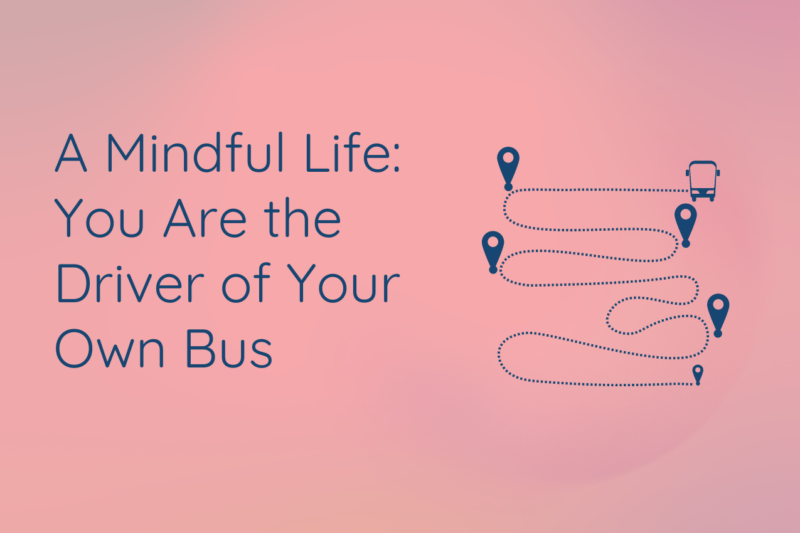A Mindful Life: You Are the Driver of Your Own Bus
Roamers Therapy | January 2024
Life’s challenges can be overwhelming; everyone deserves a space to feel heard and supported. At Roamers Therapy, we provide trauma-informed, culturally sensitive, LGBTQIA+ affirming, and evidence-based environments to help you heal, grow, and navigate your mental well-being journey. As your psychotherapist, we are here to guide you every step of the way.

Currently, mindfulness is practiced in many forms of psychotherapy and has gone far beyond the field of psychotherapy. Relatedly, studies on this topic are on the rise, and we are becoming more familiar with and exposed to the recommendation of mindfulness. However, as is well known, mindfulness is not a new method. It has been traditionally known as a Buddhist meditation practice. But what is mindfulness, and why is it now gaining popularity when it has long been a conventional method in many Eastern cultures? In its modern definition by Jon Kabat-Zinn, founder of the Stress Reduction Clinic, mindfulness is the awareness that arises through paying attention to purpose and non-judgmentally in the present moment. Mindfulness has become a fad with researchers and the mass media because of its effect on coping with stress. Recent studies on mindfulness-based stress reduction have shown that mindfulness practices provide large-scale benefits to individuals in dealing with physical and psychological distress. When struggling with physical and psychological stress, we will discuss how mindfulness can be helpful, how it can work with a metaphor, and how it can be adapted to everyday life.
So, how does mindfulness work?
Mindfulness plays an essential role in the emergence of Dielectric Behavioral Therapy, created by Marta Linehan. Linehan incorporated Mindfulness, an Eastern Zen practice, into her theory to help clients acknowledge and cope with strong negative emotions. According to Buddhist traditions, the absolute truth of life is that it is painful. Life contains many negative experiences. Although this irrefutable fact is sad, it is also useful because it helps those who practice mindfulness to deal with these negative situations; Stay in the present and accept the blessings of the moment!
Mindfulness practices consider that when emotions, thoughts, and bodily sensations become overwhelming, they can distract us from the present moment or become the main focus of our attention. So, instead of living in the present moment, we can get caught up in thoughts from the past or future. Mindfulness practices contribute to regulating emotions and self-control through experiencing the peace of the present moment. It strengthens our ability to let go of negativity from the past and worries about the future, allowing us to be more present and centered in the present moment. Being mindful does not mean ignoring thoughts, feelings, and bodily sensations originating from the past and future. Instead, it is a practice that enables the individual to accept emotions, thoughts, and physical sensations without being judgmental or allowing them to gain control.
The Bus.
Being mindful is a way of engaging with the experience of the present moment rather than seeing the moment as part of the past or future. The only goal here is the absolute experience of the moment. Let’s use the bus metaphor to explain it more simply.
In this metaphor, you are a bus driver, driving the bus of your life. We each have many, often unruly, passengers in the back of our bus. The passengers are our thoughts, feelings, memories, and bodily sensations. Sometimes, they can be overwhelming as they make remarks about the driving like: “You’re a useless driver,” “I want to go in the other direction,” and “That’s where Aunt Pat lives,” Sometimes, it can be physical discomfort and pain and internal distressing preoccupation like “your lower back sure is in pain” or “maybe you should go to the doctor.” As we cannot control external stressors, suffering, and pain, we can imagine that we may frequently experience distressing thoughts, feelings, and sensations that may want your attention. These passengers can be particularly disorienting if we are trying to focus and be in the present moment, on completing a task, enjoying our drive to work, enjoying a walk outside, or having a conversation with a loved one.
At times, the sensations, memories, or thoughts can take over and dictate our behaviors, kicking us off the driver’s seat and driving us down a path that does not align with who we are or is possibly a reaction instead of a response to a situation. In these examples, the unruly passenger is now driving, and you are taking a back seat. Mindfulness acknowledges that we will always have passengers telling us what to do. At the same time, we drive our bus and consider that some of the things passengers say may be helpful and even important. We do not necessarily ignore passengers or numb out to the cues and or the passengers’ messages. Mindfulness offers an opportunity to acknowledge who and what the passengers are, without judgment, and determine what, if any, passengers you would like to accept influence from when considering your bus route.
Suppose you find it difficult to practice mindfulness during a distressful life event. In that case, you can remember this metaphor and imagine that each passenger represents a negative thought, emotion, or bodily sensation. Then you can imagine the bus stops at the station, and these passengers get off the bus individually. Something incredibly comforting is that passengers come and go by nature, just like your negative emotions, thoughts, or bodily sensations.
How can I be more mindful?
There are many ways that an individual can try being mindful, from breathing to mindful eating and even a mindful walk. Breathing is the most common technique recommendation we receive. It is often a helpful suggestion. Breathing can be seen as the cornerstone of all Eastern philosophy and practice because it is a source of power that we can apply immediately and is essential for life. However, the critical point here is to breathe mindfully. Mindful breathing is not “doing” or ” fixing.” Mindful breathing allows us to “be” in the moment.
Let’s give an example of how you can quickly apply mindful breathing in daily life. You can start by taking a proper posture for mindful breathing. Keep your feet firmly on the ground, your chest upright, and your eyes closed. The first step is awareness. You can ask yourself: What do I feel in my body right now? Describe the bodily sensations without commenting on the causes; for example, I have pain in my lower back. As the sensation in the body goes back, bring the thoughts in your mind to the forefront and ask yourself: What am I thinking right now? Observe the thoughts in your mind without judgment, then focus your attention on your feelings and ask yourself. What am I feeling right now? The second step is to combine them. Pay attention to your breathing as these processes are happening in the background. Pay attention moment by moment only to your inhalation and exhalation. Even in this short time, your mind can go to your thoughts or other stimuli. Gently bring your attention back to the breathing each time. The third step is to expand your field of awareness. Check out your body from the top of your head to the bottom of your feet as you breathe. Notice all bodily sensations, emotions, and thoughts, and realize you are moving into a new moment with each breath. As you finish the practice, relax your body again and open your eyes.
This practice above is just an example, and if you feel that it is not working for you, you can create the proper practice for yourself. If this is something new, starting with a short amount of time, like 30 seconds, then extending it to 60 seconds can be helpful. As you become more accustomed to these practices, the passengers on the bus metaphor we used will slowly ebb and flow. The passengers will always be there, but acknowledging them non-judgmentally will decrease the intensity and impact they impose on you as you drive your bus. Practicing mindfulness can seem simple in concept, yet it can be complex in application, so take it step by step and practice being curious about what it brings to your awareness and ability to acknowledge and observe the present moment without judgment. When you are carried to the awareness of day-to-day sights, textures, sounds, smells, tastes, thoughts, and feelings, you can more easily describe and be in the present moment and prevent being the disoriented driver from being in constant reaction to unruly passengers. You can be more.
While our physical offices are located in South Loop and Lakeview neighborhoods in Chicago, Illinois for in-person sessions, we also welcome and serve clients for online therapy from anywhere in Illinois and Washington, D.C. Clients from the Chicagoland area may choose in-office or online therapy and usually commute from surrounding areas such as River North, West Loop, Gold Coast, Old Town, Lincoln Park, Lake View, Rogers Park, Logan Square, Pilsen, Bridgeport, Little Village, Bronzeville, South Shore, Hyde Park, Back of the Yards, Wicker Park, Bucktown and many more.
At Roamers Therapy, our psychotherapists are here to support you through anxiety, depression, trauma and relationship issues, race-ethnicity issues, LGBTQIA+ issues, ADHD, Autism, or any challenges you encounter. Our psychotherapists are trained in Cognitive Behavioral Therapy, Dialectical Behavioral Therapy, Psychodynamic Therapy, Acceptance, and Commitment Therapy, Person-Centered Therapy, and Gottman Therapy.
Whether you’re seeking guidance on a specific issue or need help navigating difficult emotions, we’re ready to assist you every step of the way.
Contact us today to learn more about our services and schedule a session with our mental health professionals to begin your healing journey. To get started with therapy, visit our booking page.
First, decide if you’ll be paying out-of-pocket or using insurance. If you’re a self-pay client, you can book directly through the “Book Now” page or fill out the “Self-Pay/Out-of-network Inquiry Form.” If you’re using insurance, fill out the “Insurance Verification Form” to receive details about your costs and availability. Please let us know your preferred therapist. If your preferred therapist isn’t available, you can join the waitlist by emailing us. Once your appointment is confirmed, you’ll receive intake documents to complete before your first session.
This page is also part of the Roamers Therapy Glossary; a collection of mental-health related definitions that are written by our therapists.
While our offices are currently located at the South Loop neighborhood of Downtown Chicago, Illinois, we also welcome and serve clients for online therapy from anywhere in Illinois and Washington, D.C. Clients from the Chicagoland area may choose in-office or online therapy and usually commute from surrounding areas such as River North, West Loop, Gold Coast, Old Town, Lincoln Park, Lake View, Rogers Park, Logan Square, Pilsen, Bridgeport, Little Village, Bronzeville, South Shore, Hyde Park, Back of the Yards, Wicker Park, Bucktown and many more. You can visit our contact page to access detailed information on our office location.
